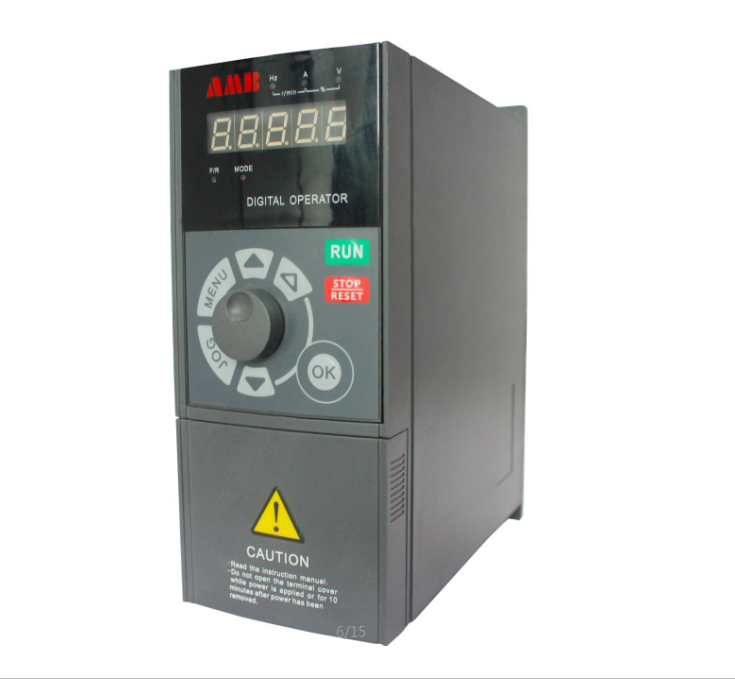
1. Before the inverter is powered on
The temperature and humidity of the surrounding environment should be detected first. If the temperature is too high, it will cause the inverter to overheat. If it is serious, it will directly cause damage to the inverter's power components and short circuit. If the air is too humid, it will cause a direct short circuit inside the inverter. When the inverter is running, pay attention to whether its cooling system is normal, such as: whether the exhaust air flow is smooth, and whether the fan has abnormal sound.
Inverters with a higher protection level, such as: Inverters above IP20 can be installed directly open. Inverters below IP20 should generally be installed in a cabinet, so how the heat dissipation effect of the inverter cabinet directly affects the normal operation of the inverter. The exhaust system, such as whether the fan rotates smoothly, whether there are dust and obstructions at the air inlet, are all places we can not ignore in our daily inspection. Whether the motor reactors, transformers, etc. are overheating and have abnormal odors; whether there is abnormal noise from the inverter and the motor; whether the current display on the inverter panel is too large or the current variation is too large; whether the output UVW three-phase voltage and current are balanced.
Second, regular maintenance
Regularly remove dust to check whether the fan inlet is blocked, and clean the air filter cooling duct and internal dust every month.
Regular inspection should be carried out once a year: check whether the screws, bolts and plug-ins are loose, and whether the input and output reactors are short-circuited to ground and phase resistance, and should normally be greater than several tens of megohms. Whether the conductors and insulators are corroded, if necessary, wipe them off with alcohol in time. Measure the smoothness of the voltage of the output of the switching power supply, such as: 5V, 12V, 15V, 24V and other voltages. If the contactor of the contactor has traces of ignition, it is necessary to replace the new contactor of the same model or larger than the original capacity; confirm the correctness of the control voltage and perform a sequence protection operation test; confirm that the protection display circuit is normal; Balance of output voltage when running alone.
Conscientiously do the daily maintenance and overhaul of the inverter, the content mainly includes:
1. Dust the inverter regularly, focusing on the rectifier cabinet, inverter cabinet and control cabinet. If necessary, remove the rectifier module, inverter module and circuit boards in the control cabinet for dust removal. Whether the lower air inlet and upper air outlet of the inverter are dusty or blocked due to excessive dust accumulation. The inverter requires large ventilation due to its own heat dissipation, so after a certain period of operation, the surface area is very dusty, and it must be cleaned and dusted regularly.
2. Open the front door of the inverter and open the rear door, and carefully check the AC and DC busbars for deformation, corrosion, and oxidation, and whether the screws at the connection points of the busbars are loosened. Use insulation sheet or column for aging cracking or deformation, if it should be replaced in time, re-tighten, and the deformed busbar must be corrected and reinstalled.
3. After removing dust from circuit boards and busbars, carry out necessary anticorrosive treatment, apply insulating paint, and remove the burrs from the busbars that have experienced partial discharge and arcing. For damaged insulation boards, the damaged parts must be removed, and insulation boards with corresponding insulation grades should be used in the vicinity of the damage, and the insulation should be tightened and tested and considered qualified before being put into use.
4. Whether the fan in the rectifier cabinet and inverter cabinet runs and rotates normally. When the machine is stopped, turn it by hand to observe whether the bearing is stuck or noise. Replace the bearing or repair if necessary.
5. Conduct a comprehensive inspection of the input, rectifier and inverter, and DC input fast-melting, and replace it in time if found to be burnt out.
6. Whether the capacitor in the intermediate DC circuit has liquid leakage, whether there is expansion, bubbling or deformation of the casing, whether the safety valve is ruptured, and the capacitor capacity, leakage current, and withstand voltage can be tested under conditions. Capacitors should be replaced. New capacitors or capacitors that have not been used for a long time should be passivated before replacement. The use period of filter capacitor is generally 5 years. If the use time is more than 5 years, and the capacitor capacity, leakage current, and voltage resistance are significantly deviated from the detection standard, it should be partially or completely replaced as appropriate.
7. Electrically test the diodes and GTO multimeters of the rectifier and inverter parts, determine their forward and reverse resistance values, and make a careful record in the form prepared in advance to see if the resistance between the electrodes is normal. Whether the consistency of the devices of the same model is good, replace them if necessary.
8. Check the main contactors and other auxiliary contactors in the A1 and A2 incoming cabinets, and carefully observe the dynamic and static contacts of each contactor for any arcing, burrs, or surface oxidation, unevenness. If such problems are found, they should be dealt with accordingly. Replace the dynamic and static contacts to ensure safe and reliable contact.
9, carefully check the terminal row for aging, loosening, whether there is a hidden short-circuit failure, whether each connection line is connected firmly, whether the wire is damaged, and whether the circuit board plug connector is firm. Whether the connection between the main power cable and the main power cable is reliable, whether there is heat and oxidation at the connection, and whether the grounding is good.
10. Whether the reactor has abnormal tweets, vibrations or odors.
In addition, conditions can be measured on the filtered DC waveform, inverter output waveform and input power harmonic components.
Replacement of spare parts
The inverter is composed of various components, some of which will gradually degrade and deteriorate after long-term work. This is also the main reason for the failure of the inverter. In order to ensure the long-term normal operation of the equipment, the following components should be replaced regularly:
1.Cooling fan
The power module of the inverter is a device that generates severe heat. The heat generated by continuous operation must be discharged in time. The life of a general fan is about 10kh ~ 40kh. According to the continuous operation of the inverter, the fan must be replaced once every 2 to 3 years. Direct cooling fans are divided into two lines and three lines. One line of the two line fans is positive and the other line is negative. Do not connect the fan incorrectly when replacing it. There is also a detection wire outside the negative pole. Be careful when replacing it, otherwise it will cause the inverter to overheat. The AC fan is generally divided into 220V and 380V. Do not mistake the voltage level when replacing it.
Filter capacitor
Intermediate DC loop filter capacitor: Also called electrolytic capacitor, its main function is to smooth the DC voltage and absorb the low-frequency harmonics in DC. The heat generated by its continuous operation and the heat generated by the inverter itself will speed up the drying of its electrolyte. It directly affects the size of its capacity. Under normal circumstances, the service life of the capacitor is about 5 years. It is recommended to check the capacitor capacity regularly once a year. Generally, the capacitor should be replaced with a new filter capacitor if its capacity is reduced by more than 20%.

|
|

|
| The public, | Mobile station |
 0755-81719517
0755-81719517
|
|
 0755-81719530 0755-81719530 |
 [email protected] [email protected] |
 Floor 1, 5 and 6, building 7, lijincheng science and technology industrial park, gongye dong road, longhua new district, shenzhen Floor 1, 5 and 6, building 7, lijincheng science and technology industrial park, gongye dong road, longhua new district, shenzhen |
|